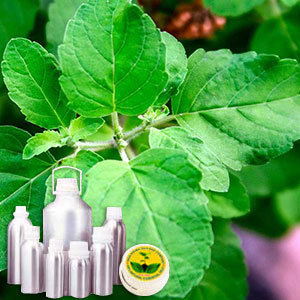Botonical Name | : | Ocimum Basillicum | |
CAS # | : | 84775-71-3 | |
Country of Origin | : | India | |
Color & Odor | : | pale greenish yellow in color with sweet, spicy, herbaceous odor | |
Solubility | : | Insoluble in water, soluble in alcohol and oils | |
Specific Gravity | : | 0.940 – 0.950 @ 25°C | |
Optical Rotation | : | -14.0 to -5.0 | |
Refractive Index | : | 1.5000 – 1.5090 @ 20°C | |
Flash Point | : | 48°C | |
Plant Part Used | : | Leaves | |
Extraction Method | : | Steam Distillation |
DESCRIPTION:
Indian basil (Ocimum tenuiflorum), also called sacred basil, belongs to the mint family, as does the sweet basil more commonly found in America. This cultivar differs slightly in both taste and appearance from sweet basil. The leaves are smaller and have a strong liquorish taste and aroma. Known as tulsi in India, it is not used as a culinary herb, but is thought to have great medicinal value and is used to treat a wide variety of illnesses. CONSTITUENTS:
Linalol, Methyl Chavicol, Eugenol, Limonene, Citronella.AROMATIC SUMMARY / NOTE / STRENGTH OF AROMA:
Basil Oil is very famous for its sweet flavor and aroma.BLENDS WITH:
Lavender, Bergamot, Clary Sage and Geranium .COMMON NAMES:
Tulsi .USES:
This is used to prepare Indian, Vietnam, Cambodia, Italian, Southeast Asian Thailand and Laos cuisines. In is also used for indigestion, stress, sinusitis, insect bites, anxiety, bacterial infections, headache, muscle relaxation, depression, panic attacks, hair loss, insomnia, menstrual cramps and so on.


































